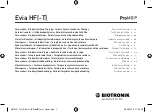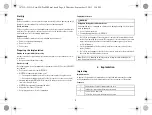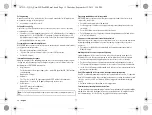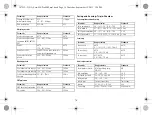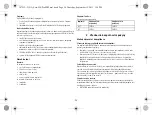
en • English
11
Setting sensing
Manually set parameters can be unsafe. For example, unsuitable far-field protection
may impede sensing of intrinsic pulses.
• Use automatic sensitivity control.
Setting the sensitivity
A value set to < 2.5 mV/unipolar for device sensitivity may result in noise caused by
electromagnetic fields.
• Therefore, it is recommended that a value of ≥ 2.5 mV/unipolar be set according to
paragraph 28.22.1 of the EN 45502-2-1 standard. Setting sensitivity values < 2.5
mV/unipolar requires explicit clinical need. Values like these may only be set and
maintained with physician supervision.
Preventing device-induced complications
BIOTRONIK devices feature several functions to prevent device-induced complications
to the greatest extent possible:
• Measure the retrograde conduction time.
• If the function is not yet automatically set: activate PMT protection.
• Set the VA criterion.
Information on magnet response
Applying a magnet or the programming head can result in an unphysiological rhythm
change and asynchronous pacing. The magnet response is set as follows in the stan-
dard program of BIOTRONIK pacemakers:
• Asynchronous:
For the duration of the magnet application – mode D00 (possibly V00 / A00) without
rate adaptation;
Magnet rate: 90 bpm
• Automatic:
For 10 cycles – mode D00, subsequently mode DDD without rate adaptation;
Magnet rate: 10 cycles with 90 bpm, subsequently set basic rate
• Synchronous:
Mode DDD without rate adaptation;
Magnet rate: set basic rate
Preventing conduction of atrial tachycardia
BIOTRONIK devices feature several functions to prevent conduction of atrial tachy-
cardia to the ventricle(s):
• Set mode switching for indicated patients.
• Set the upper rate and the refractory periods to prevent abrupt ventricular rate
switching.
• Prefer Wenckebach response and avoid 2:1 behavior.
• Set all parameters so as to prevent constant changing between atrial and ventric-
ular-controlled modes.
Phrenic nerve stimulation that cannot be terminated
With LV pacing, chronic phrenic nerve stimulation can in rare cases not be terminated
by reprogramming the available left ventricular pacing configurations or by other
measures.
• Possibly set a right ventricular mode both in the permanent program and for
Mode Switching.
Avoiding risks in the case of exclusive LV pacing
Lead dislodgement in the case of exclusive left ventricular pacing could pose the
following risks: loss of ventricular pacing as well as induction of atrial arrhythmia.
• Consider sensing and pacing parameters with reference to loss of therapy.
• Exclusive LV pacing is not recommended for patients who depend on the device.
• Take possible interruption of automatic Active Capture Control into consideration.
• In the case of follow-ups and threshold tests, take loss of synchronized ventricular
pacing into consideration.
If an ICD is implanted at the same time, do not permit unipolar pacing
If an ICD is implanted in addition to a pacemaker and a lead failure occurs, it is possible
to switch to unipolar pacing after resetting the pacemaker or using the automatic lead
check. As a result, the ICD could falsely inhibit or trigger tachyarrhythmia therapy
activity.
• Unipolar leads are not permitted in this configuration.
Consider power consumption and service time.
The pacemaker permits programming of high pulse amplitudes with long pulse widths
at high rates to be able to adequately treat even rare diagnoses. In combination with
low lead impedance, this results in a very high level of power consumption.
Note:
See information pertaining to replacement indications for magnet behavior at
ERI.
387513--D_GA_Evia-HF-ProMRI_mul.book Page 11 Thursday, September 12, 2013 3:34 PM

